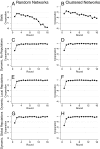Cooperation, clustering, and assortative mixing in dynamic networks
- PMID: 29339478
- PMCID: PMC5798352
- DOI: 10.1073/pnas.1715357115
Cooperation, clustering, and assortative mixing in dynamic networks
Abstract
Humans' propensity to cooperate is driven by our embeddedness in social networks. A key mechanism through which networks promote cooperation is clustering. Within clusters, conditional cooperators are insulated from exploitation by noncooperators, allowing them to reap the benefits of cooperation. Dynamic networks, where ties can be shed and new ties formed, allow for the endogenous emergence of clusters of cooperators. Although past work suggests that either reputation processes or network dynamics can increase clustering and cooperation, existing work on network dynamics conflates reputations and dynamics. Here we report results from a large-scale experiment (total n = 2,675) that embedded participants in clustered or random networks that were static or dynamic, with varying levels of reputational information. Results show that initial network clustering predicts cooperation in static networks, but not in dynamic ones. Further, our experiment shows that while reputations are important for partner choice, cooperation levels are driven purely by dynamics. Supplemental conditions confirmed this lack of a reputation effect. Importantly, we find that when participants make individual choices to cooperate or defect with each partner, as opposed to a single decision that applies to all partners (as is standard in the literature on cooperation in networks), cooperation rates in static networks are as high as cooperation rates in dynamic networks. This finding highlights the importance of structured relations for sustained cooperation, and shows how giving experimental participants more realistic choices has important consequences for whether dynamic networks promote higher levels of cooperation than static networks.
Keywords: altruism; cooperation; dynamic networks; network science; reputation.
Conflict of interest statement
The authors declare no conflict of interest.
Figures





Similar articles
-
Prosocial Orientation Alters Network Dynamics and Fosters Cooperation.Sci Rep. 2017 Mar 23;7(1):357. doi: 10.1038/s41598-017-00265-x. Sci Rep. 2017. PMID: 28336925 Free PMC article.
-
Oxytocin and the Punitive Hub-Dynamic Spread of Cooperation in Human Social Networks.J Neurosci. 2022 Jul 27;42(30):5930-5943. doi: 10.1523/JNEUROSCI.2303-21.2022. Epub 2022 Jun 27. J Neurosci. 2022. PMID: 35760532 Free PMC article.
-
Networks of reliable reputations and cooperation: a review.Philos Trans R Soc Lond B Biol Sci. 2021 Nov 22;376(1838):20200297. doi: 10.1098/rstb.2020.0297. Epub 2021 Oct 4. Philos Trans R Soc Lond B Biol Sci. 2021. PMID: 34601917 Free PMC article. Review.
-
Strategy evolution on dynamic networks.Nat Comput Sci. 2023 Sep;3(9):763-776. doi: 10.1038/s43588-023-00509-z. Epub 2023 Sep 11. Nat Comput Sci. 2023. PMID: 38177777
-
Reputation and socio-ecology in humans.Philos Trans R Soc Lond B Biol Sci. 2021 Nov 22;376(1838):20200295. doi: 10.1098/rstb.2020.0295. Epub 2021 Oct 4. Philos Trans R Soc Lond B Biol Sci. 2021. PMID: 34601915 Free PMC article. Review.
Cited by
-
Inequality and cooperation in social networks.Sci Rep. 2022 Apr 26;12(1):6789. doi: 10.1038/s41598-022-10733-8. Sci Rep. 2022. PMID: 35474324 Free PMC article.
-
Free neighborhood choice boosts socially optimal outcomes in stag-hunt coordination problem.Sci Rep. 2021 Apr 8;11(1):7745. doi: 10.1038/s41598-021-87019-y. Sci Rep. 2021. PMID: 33833291 Free PMC article.
-
The effects of reputation on inequality in network cooperation games.Philos Trans R Soc Lond B Biol Sci. 2021 Nov 22;376(1838):20200299. doi: 10.1098/rstb.2020.0299. Epub 2021 Oct 4. Philos Trans R Soc Lond B Biol Sci. 2021. PMID: 34601921 Free PMC article.
-
Tightly Bound: The Relationship of Network Clustering Coefficients and Reincarceration at Three Therapeutic Communities.J Stud Alcohol Drugs. 2020 Sep;81(5):673-680. doi: 10.15288/jsad.2020.81.673. J Stud Alcohol Drugs. 2020. PMID: 33028481 Free PMC article.
-
Human cooperation in changing groups in a large-scale public goods game.Nat Commun. 2022 Oct 27;13(1):6399. doi: 10.1038/s41467-022-34160-5. Nat Commun. 2022. PMID: 36302777 Free PMC article.
References
-
- Kollock P. Social dilemmas: The anatomy of cooperation. Annu Rev Sociol. 1998;24:183–214.
-
- Granovetter M. Economic action and social structure: The problem of embeddedness. Am J Sociol. 1985;91:481–510.
-
- Nakamaru M, Matsuda H, Iwasa Y. The evolution of cooperation in a lattice-structured population. J Theor Biol. 1997;184:65–81. - PubMed
-
- Axelrod R. The Evolution of Cooperation. Basic Books; New York: 1984.
Publication types
MeSH terms
LinkOut - more resources
Full Text Sources
Other Literature Sources
Miscellaneous

